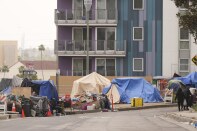Truth matters. Community matters. Your support makes both possible. LAist is one of the few places where news remains independent and free from political and corporate influence. Stand up for truth and for LAist. Make your year-end tax-deductible gift now.
LA expands ban on sleeping, camping in public areas to include parts of Chatsworth

L.A. City Council members voted Tuesday to expand a policy that bans people from sleeping in some public areas despite a city report last year that warned enforcement of the rules was failing.
The resolution, approved in a 11 to 2 vote Tuesday, adds a Chatsworth intersection to zones that ban camping. The policy, known as 41.18, prohibits people experiencing homelessness from sitting, lying down, sleeping or keeping their belongings in designated public areas.
Councilmember John Lee, who introduced the resolution for District 12, called the policy effective.
“ 41.18 is a tool that we use for engagement to try to get people into services, but sometimes that does lead to us diving in further when we find that there are illegal narcotics ... at the site," he said in an interview after the meeting.
About the additions
The vote added Superior Street and Deering Avenue in Chatsworth to the city’s 41.18. enforcement zones.
The resolution cites crime data, community challenges and 26 arrests for the first few months of the year.
“All local businesses near this intersection have expressed concerns with the noticeable crime increase and believe that this spike in crime is directly linked to people experiencing homelessness,” the resolution states, adding that police investigations have directly connected people experiencing homelessness to confirmed crimes.
Of the 26 arrests from this year, a dozen were for narcotic possession and nine were for trespassing. The other five arrests were one-offs during that time period, according to the resolution, including for grand theft auto and assault with a deadly weapon.
For comparison, there were 17 total arrests in the area last year. A majority were 41.18 violations, according to the resolution.
Unequal enforcement
The ordinance continues to not be enforced evenly across the city.
What is 41.18?
It’s one of the city’s most controversial enforcement laws related to homelessness. Versions of the rule have been around for decades, but more recent changes to how it’s used have been fiercely debated, including among council members.
- Under changes approved in 2021, council members can designate areas in their district — known as 41.18 zones — where unhoused people cannot sit, lie down, sleep, or keep belongings on sidewalks or other public areas. People are supposed to receive advanced warning and get help finding shelter before encampments are cleared.
What’s happened since then? Nearly a year ago, council members ordered a report assessing what 41.18 was costing and whether it was working to bring people indoors and prevent encampments from coming back. That report was due in June, but still has not been released.
Devonshire, West L.A. and downtown appear to be hot spots, according to data from the L.A. City Controller’s office.
There were about 4,360 arrests from 2021 through 2024 under the ordinance, and Lee’s district was responsible for a little more than a third.
"We have more arrests because yes, we are being more aggressive of going out," Lee said.
Councilmember Traci Park’s 11th district had the second highest number of arrests with a little more than 700 in the same period — hundreds less than Lee. They were followed by Councilmember Eunisses Hernandez’s 1st District with 515 arrests.
For comparison, there were 1,913 arrests in 2023. That was more than all of 2021 and 2022 combined.

Unhoused people who are accused of violating the ordinance can be hit with an infraction, which can lead to a fine, or a misdemeanor, which can lead to a fine and jail time, enforced by the Los Angeles Police Department. About 42% of the arrests were misdemeanors, according to the controller’s data.
Why it matters
Last March, LAist obtained a leaked copy of a council-ordered analysis that found 41.18 had been ineffective at keeping areas clear of encampments and getting people housed. The report was due by June 2023, but was hidden from the public for nearly a year after the deadline and wasn’t shared with several council members, including Nithya Raman, chair of the housing and homelessness committee. Raman, and Hugo Soto-Martínez, voted against Tuesday’s resolution.
The council has worked to expand the policy at least 15 times since the LAist story was published more than a year ago.
The analysis, from the Los Angeles Homeless Services Authority, found that 41.18 failed to keep the vast majority of its areas clear of encampments and was “generally ineffective” at helping people get into housing.
The analysis was criticized by several council members, with then-Council President Paul Krekorian accusing LAHSA’s work of being “clearly faulty and incomplete at best, and perhaps even deliberately misleading.”
How did we get here? Who’s in charge of what? And where can people get help?
- Read answers to common questions around homelessness in the L.A. region.
The camping ban was viewed by some council members and housing activists as a cruel crackdown that criminalized poverty and put public spaces off limits for people unable to access shelter that’s in short supply.
Supporters, on the other hand, cheered the change as a step to make schools and other places safer by removing encampments, and argued that shelter beds are available.











